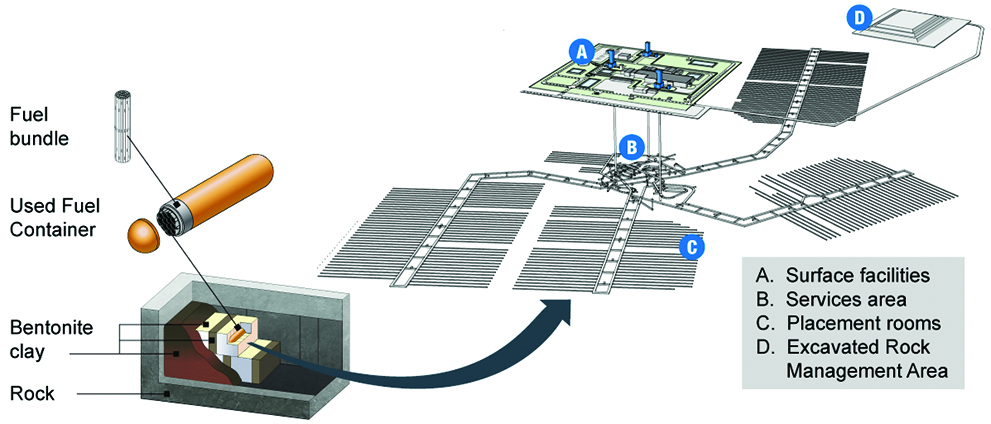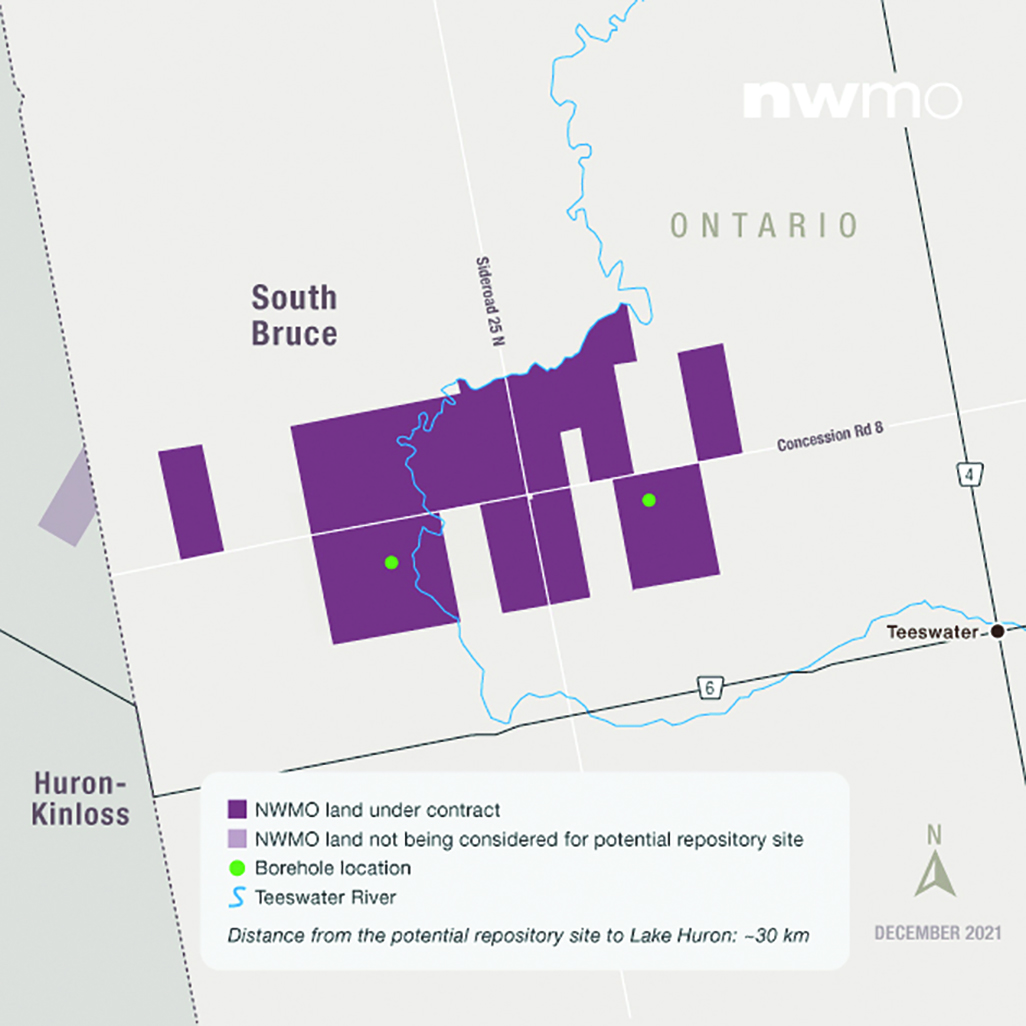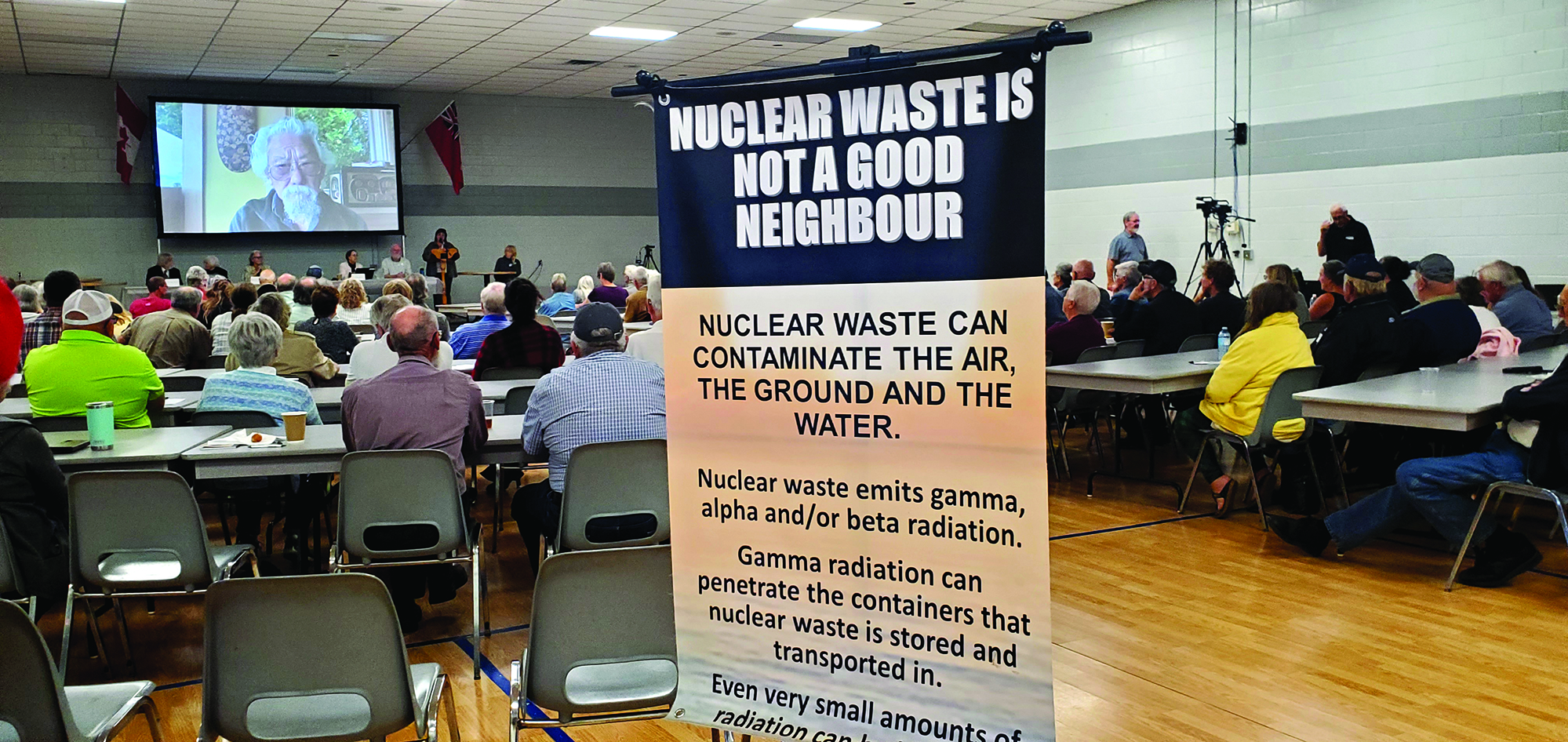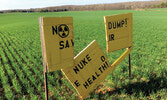By Mel Luymes
On November 28, 2024, the Nuclear Waste Management Organization (NWMO) announced that it would be moving forward with its plan to create a Deep Geological Repository (DGR) for high-level spent nuclear fuel in the Wabigoon Lake Ojibway Nation- Ignace region just north of Lake Superior.
While that may not mean a lot to some readers, it meant an awful lot to the community of South Bruce. For more than a decade, our neighbours near Teeswater and the surrounding areas have been wrestling with several important issues about their safety, economy and community priorities, all while learning much more about the nuclear industry than the average rural citizen.
In late October, the community of South Bruce took to the polls for a referendum to decide whether they would be a willing host for the DGR. Nearly 70 per cent of the 4525 electors voted, and 51 per cent voted yes. Such a close vote demonstrated the growing tension and division that the community was no doubt feeling over the last four years.
In some ways, it was like the wind, development, or pipeline projects that have divided other rural communities in this area. But it differed in many other ways because it involved a community vote that would impact generations not yet born. As well, community engagement took place during a global pandemic, making it difficult to separate the two issues, both of which involved personal safety and mistrust of the government.
Background
In Ontario, approximately 60 per cent of our electricity is generated by nuclear power and we’ve been using it since the 1960s. The largest plant is Bruce Power, near Kincardine, with eight CANDU (CANada Deuterium Uranium) reactors, and there are others in Ontario (Pickering and Darlington), Quebec and New Brunswick. While nuclear energy is much cleaner for the environment in many respects, we are left with bundles of spent uranium in small ceramic pellets, bundled into rods the size of fireplace logs. These will remain radioactive and hazardous for tens of thousands of years, long after we are gone. Currently, Canada has over 3 million of these bundles in interim storage at various sites, above ground and closely monitored, and this number is only increasing.
The Nuclear Waste Management Organization (NWMO) is a non-profit organization made by federal legislation in 2002, tasked with finding a long-term solution for Canada’s spent nuclear fuel. They spent years consulting with experts and communities to review all the options. Several options were considered, and they decided that the best plan was to encapsulate the bundles in a multi-barrier system which includes copper-coated steel containers and bentonite clay emplaced in a rock geosphere and buried deep (approximately 2000 feet) in underground tunnels in the bedrock. This would be a permanent storage, capable of withstanding several future Ice Ages, but the bundles would be retrievable in the case that better technology or solutions were found in the future.

The NWMO’s next step was to find a willing host for this Deep Geological Repository (DGR) and it would need to be a place that had the proper bedrock, potential for transportation infrastructure and willing host communities. Once a site was selected, a multi-year regulatory process would begin and, after it was licenced, the DGR would take approximately 10 years to build. Followed by another 50 years of transporting, repackaging and storing the fuel rods into the DGR, followed by ongoing monitoring.
When the NWMO put the call out, twenty-two communities expressed interest by 2012, including South Bruce, Huron Kinloss, Saugeen Shores and Brockton, among others.
It was critical for the NWMO that a host community be both informed and willing, in order to proceed. Community Liaison Committees (CLC) were formed in the interested communities in 2012, appointed by their local councils. For South Bruce, the mandate of the CLC was three-fold: to engage, educate, and listen to the community, to gather technical and social research and information, and to provide advice to Council regarding the NWMO’s Site Selection Process.
Several local citizens applied to volunteer for the CLC in South Bruce. There were twelve members of the CLC, including two student representatives and two representatives from South Bruce Council. Meetings were announced two weeks in advance, were open to the public, accepted delegations, included information sessions from experts about the entire value-chain of the nuclear industry and had regular updates by the NWMO about their study results. Another task of the CLC was to distribute $30,000 per year of NWMO funding to community applications to the Early Investments in Education and Skills (EIES) program.
Despite the notices mailed to all residents each month, there were only a handful of people – besides the committee – that attended for the first eight years. Perhaps the community just didn’t see the urgency at that time, with any decision still being years in the future.
During this time, the South Bruce Nuclear Exploration Team was also developed as a new department of the Municipality of South Bruce. While these staff worked for the Municipality, their time and expenses were submitted to the NWMO for reimbursement. Community engagement, assessments and other tasks related to the proposed DGR was an extra burden on Municipal staff in many other departments as well, and to ensure the Municipality had the necessary resources, these staff expenses were also reimbursed by the NWMO.
Between December 2019 and February 2020, a series of Visioning Sessions took place in the community. Facilitated by AECOM, 144 community members participated and shared their expectations and aspirations for the DGR if it were to be held in South Bruce. The result was 36 Guiding Principles that would promise safety for people and the environment, ensure meaningful community benefits, and guarantee community involvement in decision-making processes.
One by one, interested host communities dropped off and by 2020, it was only Huron Kinloss and South Bruce still in the running from Southern Ontario, along with Ignace in the North.
Site Proposal and Response
On January 24, 2020, the NWMO announced that they had secured enough land in South Bruce to proceed, and Huron-Kinloss was no longer considered. The land access process had begun in both municipalities in May 2019. The NWMO had not disclosed the purchase and optioning of 1300 acres of land northwest of Teeswater to the public until the announcement was made.
When the land was announced, the community responded in a big way. Michelle and Gary Stein farm sheep and beef cattle next to the proposed 1300 acres and were quite concerned. Michelle attended a meeting of other concerned citizens hosted by her neighbours on February 8, and there were about 45 people there. Michelle went on to express her concerns as a delegation to the CLC on March 5 in Formosa, and some estimate there were about 200 people at that meeting.

The March CLC was the last meeting before the pandemic lock-down. The meetings moved to Zoom, an online platform, where the CLC continued to meet monthly until November 2024 for a total of 110 meetings.
An anti-DGR group had quickly organized, calling themselves Nuclear Tanks, No Thanks (NTNT) when the media asked them, but eventually became Protect Our Waterways – No Nuclear Waste (POW) when they later incorporated as a non-profit organization. In April 2020, the community began to see a slew of hand-painted yellow signs along the road that were made by POW member, Rita Groen. The group went door to door, getting 1600 signatures on a petition that they presented as a delegation to South Bruce Council in June 2020.
Through the pandemic, the group organized parades, delegations, and had countless Zoom meetings, consulting with other groups like Wellington Water Watchers and Northwatch. They hosted a local Water Walk with Indigenous women walking from Neyaashiinigmiing (formerly Cape Croker) to the proposed DGR site. Michelle Stein and Rita Groen also participated in a northern Water Walk in solidarity with the Wabigoon Lake Ojibway Nation (Ignace) in June 2021.
From the start, it was made clear that the Saugeen Ojibway Nation (SON) would have a separate consultation with the NWMO and a separate decision to be made after the South Bruce community had made its decision. The SON had previously voted an overwhelming “No” in 2020 to a DGR for low- to intermediate- level nuclear waste disposal on-site at Bruce Power.
As POW got more vocal, so did an alternative voice in favour of hosting the DGR. In May 2020, Sheila Whytock, started a Facebook group, Willing to Listen – South Bruce Proud, and connected with like-minded community members. Originally a beef farmer from Orillia, Sheila has been an operator at Bruce Power since 2013 and felt that POW was not accurately describing the nuclear industry. She hosted 36 podcast episodes with several nuclear professionals from 2021-2023, including representatives from the Waste Isolation Pilot Plant (WIPP) in New Mexico and others from around the world, exploring issues of safety, impact on agriculture, and more. The Willing to Listen group also created newsletters, videos and held community events.
Referendum for South Bruce
In the summer of 2021, the municipality hosted a series of Willingness Workshops that gathered the community’s opinion about how they would determine if they were willing to host the DGR. Despite there being several ways to participate online and remotely, only 229 residents participated, discussing the pros and cons of various options. While a referendum was the most liked option as a determination of willingness, it should be noted that it was also the most disliked.
POW made a separate campaign calling for the DGR referendum to be held in 2022 as part of the municipal election that October. Because many of the geological and socio-economic studies were still ongoing and wouldn’t be done until 2023, it was decided a referendum would be held separately, after the studies were completed.
The group instead ensured there were vocal opponents to the DGR running in each Ward for the October 2022 election, including Michelle Stein who ran for her ward and Rita Groen who ran for Mayor. The election saw only one of the group, Audrey Bross, elected by acclamation to Mildmay-Carrick Ward. Audrey resigned in February 2023, citing personal reasons.
As the results of several third-party socio-economic studies and the borehole and geological studies were released, it was looking favourable that South Bruce would be a suitable host for a DGR. In July 2023, a small delegation of representatives from Council, the CLC, staff and both the Willing to Listen and POW groups went to Finland to see firsthand the Onkolo Spent Fuel Repository, which is the world’s first DGR for high-level nuclear waste and hopes to receive spent fuel rods in the near future.
While the DGR debate never really subsided in the community, it ramped up in earnest in May 2024, when a hosting agreement was signed with NWMO that, if selected, would entitle South Bruce to 418 million dollars over the next 138 years.
At this time, the community referendum date was announced for the end of October. It was made clear that a referendum, as outlined in the Municipal Elections Act, required over 50 per cent of community to participate and over 50 per cent to vote “Yes” to be considered a willing host. If voter turnout was under half, the decision would be made by the South Bruce council. The vote was to be run with an online platform, Simply Voting, that had been used in the previous municipal elections with no concerns. It would allow for students or others out of town to participate; however, POW argued that a paper ballot would be more verifiable. When the voter cards were mailed out, they also expressed concern that not all residents received a card.
POW hosted an event on October 5, just a few weeks before the referendum. They brought in Dr. David Suzuki over Zoom, who prompted applause as he suggested that the DGR be instead put under the largest concentration of beneficiaries of nuclear energy, that it be buried under Toronto. A panel of speakers included Dr. Gordon Edwards, co-founder and President of Canadian Coalition for Nuclear Responsibility, whose information they had trusted and relied on for the last years.
There was concern expressed that the group should not be promoting misinformation, especially at the eleventh hour. POW argued that their information was not misinformation, believing that a DGR would pose significant risks to their community that the NWMO and other community members were simply ignoring.

Decision Time
At the time of South Bruce’s decision week, it was still uncertain if the Wabigoon Lake Ojibway Nation would be a willing host. On July 10, 2024, Ignace Council had voted that they would be willing. They had not had a referendum; instead, they had agreed to a door-to-door survey in their community of 1200 people. Still, just like in South Bruce, the Indigenous group would have a separate vote of willingness.
By the end of the day on October 28, 2024, the referendum results were posted on the South Bruce website. 3038 of the 4525 electors voted (69.3 per cent); 1604 voted “Yes” (51.2 per cent), 1526 voted “No” (48.8 per cent) and eight people declined their ballot. While the POW group was not surprised that South Bruce got a “Yes” vote, they were surprised that it was so close. Still, the next decision would be up to the Saugeen Ojibway Nation (SON) and, and they had indicated in May that it would be unlikely that they would vote on the DGR before the end of the year.
On November 18, the Wabigoon Lake Ojibway Nation voted “Yes,” that they were a willing host for the DGR in Ignace.
Ten days later, on November 28, the NWMO announced that they had pulled the trigger and would move forward with Ignace, no longer considering South Bruce as a potential host for the DGR. The Municipality of South Bruce received 4 million dollars from the NWMO for indicating it was a willing host and will receive another 4 million now that NWMO has selected another site.
While the POW organizers are relieved that the DGR for high-level spent fuel will not be near Teeswater, they say they are continuing to work in solidarity with their counterparts in Ignace. They also remain suspicious of the 1300 acres of land and if the NWMO has an alternative plan for it.
On December 2, Sheila Whytock posted a heartfelt message on the Willing to Listen Facebook page about the “slap in the face” from NWMO, that expressed regret, anger, hope and pride in her community. “Our community has so many strong, resilient and relentless individuals who want to see great things for South Bruce,” she writes. Perhaps she could have been writing about the individuals on either side of the DGR issue; both felt they were fighting in the best interest of their community.
The community of South Bruce has changed, but not only from the DGR debate. Back in 2012, when it first volunteered to engage with NWMO as a potential host site, there was concern that the community was struggling economically, and perhaps many saw the DGR as an opportunity to bring new, high-paying jobs to the area. Since then, the town has been growing, with a 60-million-dollar investment that Gay Lea put into its Teeswater plant, the Kinectrics laundry plant for Bruce Power, and 800 new homes proposed for the municipality. With more remote work opportunities, dreams of rural living will be within reach for many more people.
Perhaps all communities and families in our Rural Voice readership area have found themselves at a crossroads at some point, have experienced difficult changes and divisions over proposed development, during the pandemic or for other reasons. In many ways, we can relate to the pain of strained relationship and the difficult conversations that residents of South Bruce had over the past years. Maybe it is true that time heals a community, but only time will tell. In the wake of the DGR issue, our thoughts are with the community of South Bruce. ◊


